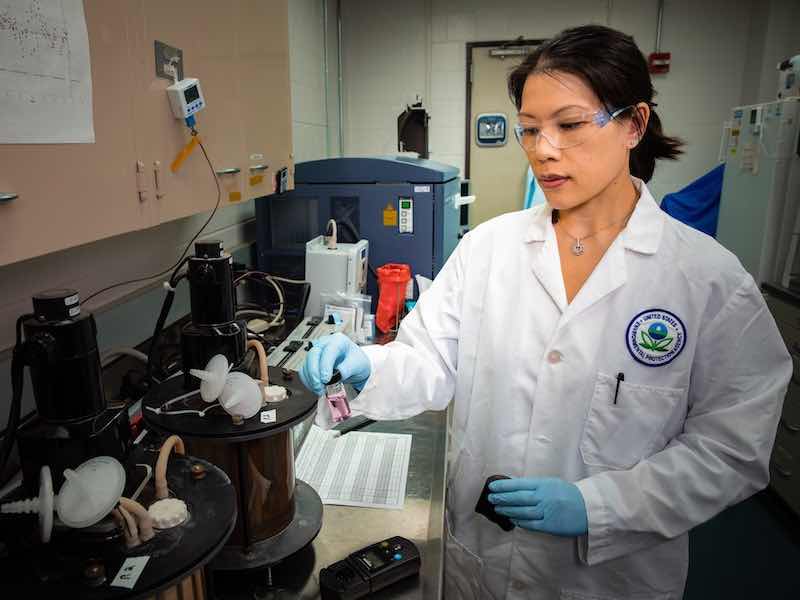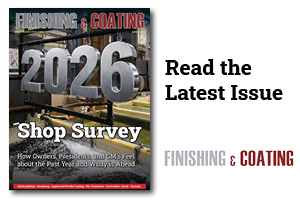The U.S. Environmental Protection Agency says it will start visiting chrome finishers in the next few months to gather information on per- and poly-fluoroalkyl substances (PFAS).
Robert Daguillard, an EPA Public Affairs Officer, told www.FinishingAndCoating.com that the agency is finalizing a finishing industry survey that it will present for public comment later this year or in early 2023.
“The (EPA) will also conduct site visits and a wastewater sampling campaign to better understand the types of wastewaters being generated by chrome finishers and the performance of treatment technologies and practices being used to manage them,” the agency says.
The EPA says that "site visits usually aren’t mandatory, and we pick the sites based on what we know about their current operations and installed technologies. Sources of the that information include permits, NASF, EPA regional offices, and states. We would coordinate with any identified facility to arrange the site visit along with NASF, the EPA regional office, and the state environmental agency. We would have a teleconference in advance to discuss objectives of the site visit."
A timeline from the EPA includes the following:
- The EPA will present a finishing industry survey PFAS to the public for comment late in 2022 or early 2023. The survey will be used to collect data from finishing operations.
- Following incorporation of public input, the EPA will conduct its industry survey later in 2023.
- The EPA says it will visit chrome finishers in late 2022 and continue through 2023.
- A wastewater sampling program may be conducted at shops in 2023, and if warranted, the EPA will propose PFAS wastewater discharge limits in 2024 for public comment and finalize them in the following years.
FinishingAndCoating.com received the following answers from the EPA on these questions:
Q: What should metal finishers know about the rulemaking process, and how will they be involved?
EPA: EPA’s rulemaking process involves an in-depth study of an industry to understand what it does and how it manages the pollution it produces. In the case of the metal finishing industry, the Agency has studied and regulated it before: in 1983, EPA regulated the wastewater discharge of various metals and other pollutants from 6 core and 40 ancillary operations performed by it. Following continued study since then, the Agency observed the discharge of per- and poly-fluoroalkyl substances (PFAS) by chrome finishers and, in 2021, began an evaluation of the need to regulate them. This process of rulemaking involves the collection of technical and financial data from them using various means, an evaluation of the collected data, and development, if possible, of discharge standards that reflect good operation of the best pollution control technologies that are affordable for the industry.
The primary involvement for metal finishers, therefore, will be for chrome finishers and with EPA’s information collection processes. The Agency is already in consultation with the National Association for Surface Finishing (NASF) to best target these collections, including refining the questionnaire that will collect the bulk of the technical and financial data needed for EPA’s analysis. The Agency will also conduct site visits and a wastewater sampling campaign to better understand the types of wastewaters being generated by chrome finishers and the performance of treatment technologies and practices being used to manage them.
Q: Will shops be contacted by the EPA for this feedback and data? If so, what should they be willing to share?
EPA: Yes. EPA’s intention is to reach out to a large portion of the chrome finishing industry to collect the data needed to achieve the goals listed above. Doing so will require the Agency to have access to detailed technical descriptions of the manufacturing and waste management operations and technologies used by such facilities, characteristics of the different types of emissions of the industry (e.g., wastewater, solid waste, and air, likely involving sample collection), along with information about the financial health of chrome finishing facilities and companies. The request for this type of data will involve multiple mechanisms, including direct contacts with chrome finishing facilities and treatment technology vendors, site visits, and an industry survey.
Please note that the provision of some of this information to EPA may be mandatory. The Agency understands that some of this information may be sensitive. Any information for which confidentiality claims are allowed may be designated as such and EPA is legally obligated to protect it from disclosure. The Agency has a decades-long history of securely collecting and managing this type of data and information providers should be confident that it will protect their data to the greatest extent possible.
Q: How will the EPA determine what shops it will visit?
EPA: Site visits usually aren’t mandatory and we pick the sites based on what we know about their current operations and installed technologies. Sources of the that information include permits, NASF, EPA regional offices, and states. We would coordinate with any identified facility to arrange the site visit along with NASF, the EPA regional office, and the state environmental agency. We would have a teleconference in advance to discuss objectives of the site visit.
Q: Any timelines that are available that metal finishers should be aware of?
EPA: As stated previously, EPA is already consulting with the industry regarding potential information collection for its rulemaking to regulate PFAS wastewater discharges. An industry survey, for example, will be presented to the public for comment late in 2022 or early 2023. Following incorporation of public input, the Agency will conduct its industry survey later in 2023. EPA will visit chrome finishers in late 2022 and continue through 2023. A wastewater sampling program may be conducted in 2023. Following analysis of all the data collected through these various efforts, if warranted, the Agency will propose PFAS wastewater discharge limits in 2024 for public comment and finalize them in the following years.
Q: If metal finishers have questions, who should they contact?
EPA: For questions about the rulemaking to regulate the discharges of PFAS from metal finishers, please contact Dr. Phillip Flanders, the lead for the rulemaking, at flanders.phillip@epa.gov or (202) 566-8323. For questions about the existing rules from the 1980s for electroplaters and metals finishers, 40 CFR 413 and 40 CFR 433, respectively, please contact M. Ahmar Siddiqui at siddiqui.ahmar@epa.gov or (202) 566-1044.

































